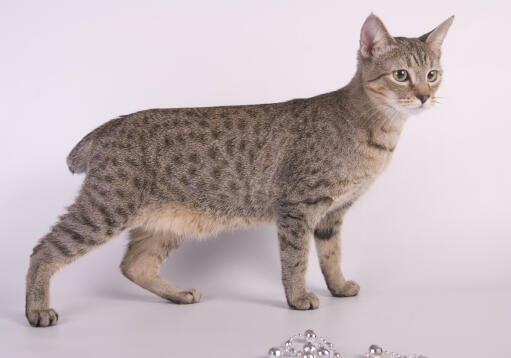Japanese Bobtail
Ever strolled through a park in Japan or flipped through a Japanese art book? You might have caught a glimpse of a peculiar feline with a fluffy puff for a tail. This is the Japanese Bobtail, a breed of domestic cat that is as rich in history as it is unique in appearance. Known for its playful, charming manner and signature short tail, this breed has been a beloved part of Japanese culture and folklore for centuries. This article is an immersion into the fascinating world of the Japanese Bobtail, giving you the lowdown on this breed’s traits, history, grooming needs, and more in an engaging and easy-to-understand format.
History of the Japanese Bobtail
The Japanese Bobtail has a long and rich history that goes back over a thousand years. This unique feline is considered a national treasure of Japan and is often seen in traditional art and folklore.
Origins in Japan
The Japanese Bobtail owes its namesake feature, a short bobbed tail, to a genetic mutation that cropped up in cats native to Japan many centuries ago. It’s believed that these short-tailed cats were first documented in Japan around the 11th century, but they may have been around even earlier. The Bobtail is truly a cat with a deep history in Japan.
Symbolic Representation in Culture and Art
Beyond just being a common pet, the Japanese Bobtail holds significant symbolic meaning in Japanese culture and art. Perhaps the most recognisable representation of a Japanese Bobtail is the ‘Maneki-neko’ or the ‘beckoning cat’ which is a common Japanese talisman believed to bring good luck and fortune. The sculpture of the cat with one paw raised in a beckoning gesture is almost always modelled after a Japanese Bobtail.
Evolution of Breed Over Time
Over time, the Japanese Bobtail breed has been carefully cultivated preserving its unique characteristics and gentle temperament. Breeders have strived to maintain the breed’s unique look and compact size, along with the unmistakable rounded, rabbit-like tail. This dedicated breeding has yielded the distinct and beloved Japanese Bobtail we recognize today.
General Characteristics of the Japanese Bobtail
The Japanese Bobtail is a medium-sized cat breed with several distinguishing characteristics setting it apart from other felines.
Physical Traits
A Japanese Bobtail’s most prominent feature is undoubtedly its short ‘bobbed’ tail. These tails can vary in length, but they typically do not exceed three inches and are unique as fingerprints to each cat. They also possess a unique muscular, lean, and elegant body that is well balanced and athletic, enhanced by their long, slender legs.
Color Variations
Japanese Bobtails can come in a variety of coat colors, but two particular patterns are most classic – the bi-color and the tri-color, or ‘mi-ke’ pattern, which is white with patches of black and red.
Size and Weight
On average, male Japanese Bobtails weigh between 7 to 10 pounds, while females weigh a little less, ranging between 5 to 7 pounds. They are generally considered to be medium in size.
Specific Traits of Japanese Bobtail
There are a few specific traits that distinctly set the Japanese Bobtail breed apart.
Bobtail Appearance and Genetic Information
The distinguishing ‘bobtail’ is not just about short length; it also has a unique shape, frequently described as appearing like a pom-pom or resembling the shape of a rabbit’s tail. This trait is caused by a dominant genetic mutation that affects tail development.
Distinctive ‘Chrysanthemum’ Fur Pattern
While different coat colors are possible, what’s most fascinating is the coat pattern each Japanese Bobtail sports. Many have a unique fur pattern where the hair appears to swirl outward from a central point like a chrysanthemum.
Variety in Eye Color
The eyes of a Japanese Bobtail can be blue, green, gold, or even odd-eyed (each eye a different color). This last variation is especially prized in the breed.
Japanese Bobtail Temperament and Personality
Japanese Bobtails are not just about good looks, they have charming personalities that make them great companions too.
General Personality Traits
These cats are known for being active, playful, and intelligent. They are also reputed for their sociable nature, loving nothing more than being around people and being the center of family activities.
Interactions with Humans
Japanese Bobtails form strong bonds with their human families. They are happy to join you in whatever you are doing and often engage in interactive play. They are also known for their vocal tendencies, readily communicating their needs or thoughts to their humans.
Interactions with Other Cats or Pets
In addition to their strong bonds with humans, Japanese Bobtails also get along well with other cats and even dogs. They’re often seen engaging in play with their fellow furry friends, making them a great addition to a multi-pet household.
Health and Lifespan of Japanese Bobtail
Japanese Bobtails are generally a healthy breed with a good lifespan.
Average Lifespan
The average lifespan of a Japanese Bobtail is around 14 to 16 years, though some have been known to live into their early twenties.
Common Health Concerns
Despite being generally healthy, some of the major health issues that affect the breed can include obesity and dental disease. However, these issues can often be managed through proper diet and oral hygiene.
Genetic Health Issues
One concern unique to the breed is a range of tail-related issues. Despite its cute and desirable bobbed tail, the gene responsible for this trait can sometimes cause spinal problems. However, these issues are rather rare thanks to careful breeding practices.
Care and Grooming for Japanese Bobtail
A Japanese Bobtail’s care and grooming requirements reflect their active and fun-loving nature.
Grooming Requirements
Thanks to their short fur, the Japanese Bobtail doesn’t require a lot of grooming. A weekly brush should suffice, helping to remove any loose hairs and keep their coat looking shiny and healthy.
Activity Levels and Exercise Needs
Japanese Bobtails are active cats that demand playtime. they enjoy a variety of games and activities and they even have a well-known love for playing fetch. Ensuring they get plenty of exercise will keep them happy and help to prevent obesity.
Feeding and Nutrition
Like all cats, Japanese Bobtails require a balanced diet that includes a good mix of proteins, fats, and carbohydrates. Feeding them high-quality cat food is vital to their overall health and well-being. Always control portion sizes to avoid overfeeding and obesity.
Breeding of Japanese Bobtail
The breeding of Japanese Bobtails is an important process that seeks to preserve the breed’s unique traits.
Breeding Standards
Breeders aim to retain the Japanese Bobtail’s classic appearance including their bobbed tail, triangular face, and high cheekbones. They also work to preserve the breed’s friendly, intelligent and active nature.
Controversies or Ethical Considerations
As with any breed, ethical breeding practices are important. This should include the consideration of genetic diversity to decrease the likelihood of health problems, ensuring proper care for breeding cats, and avoiding overpopulation.
Genetics of the Bobtail Trait
The genetics behind the Japanese Bobtail’s signature trait are quite interesting. The bobbed tail is actually due to a natural dominant mutation, meaning that if one parent is a Bobtail, the kittens have a good chance of inheriting the trait.
Japanese Bobtail in Competitions
Japanese Bobtails frequently participate in cat shows where their unique traits and striking appearance are celebrated.
Participation in Cat Shows
Often competing in the ‘short hair’ division, Japanese Bobtails regularly impress judges with their unique tail, athletic build, and striking coat patterns. They’re popular competitors given their friendly temperament and show-worthy characteristics.
Award-Winning Japanese Bobtails
Over the years, many Japanese Bobtails have taken home top honors in cat shows around the world. Their wins reflect their distinctive beauty as well as their charming and engaging personalities.
Standards for Competition
The competition standards for Japanese Bobtails focus on qualities such as their tail shape, coat color, body structure, and eye color. Contestants that best embody these distinctive traits are often considered the top contenders.
Adopting a Japanese Bobtail
If you’re thinking about making a Japanese Bobtail part of your family, here are some key points to remember.
Finding a Reputable Breeder
Finding a reputable breeder can be an important first step in adopting a healthy and well-socialized Japanese Bobtail. Good breeders will have prioritized the health and temperament of their cats over purely aesthetic attributes, providing you peace of mind in your new furry companion.
Rescue or Adoption Options
Additionally, consider adoption from a rescue organization. Rescues often have cats of all ages and might have a Japanese Bobtail or Bobtail mix that could be a perfect fit for your family.
Preparations for Bringing a Japanese Bobtail Home
Before bringing your Bobtail home, ensure you have all necessary amenities such as food, water bowls, a litter box, a scratching post, and toys. It’s also essential to prepare for quality time as Japanese Bobtails love to play and spend time with their humans.
Famous Japanese Bobtails
Over the centuries, Japanese Bobtails have left their paw prints in the annals of fame and folklore.
Real-Life Famous Japanese Bobtails
From being owned by aristocrats and royals in history to being the companions of famous modern celebrities, Japanese Bobtails have certainly made a name for themselves!
Japanese Bobtails in Media and Pop Culture
Perhaps the most well-known representation of this breed in pop culture is the ‘Maneki-neko’, a ubiquitous symbol of luck and good fortune in Japan, which is considered a part of the breed’s legacy.
Importance of the Breed in Japanese Folklore and History
In Japanese folklore, the Bobtail is often associated with good luck. They also symbolize longevity and prosperity, heralded as far back as the 11th century. No wonder they often feature in many legends and traditional artworks in Japan.
From their birth in Japan to gaining worldwide popularity, Japanese Bobtails continue to captivate with their distinctive looks and lively personalities. Whether as lucky charms or just as loving, playful pets, they forever leave paw prints in the hearts of those who live with them.







